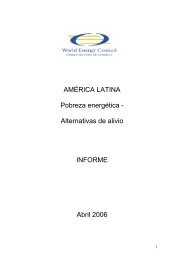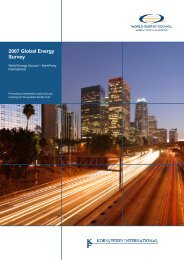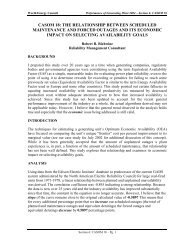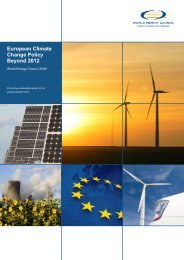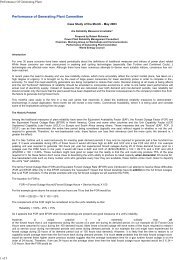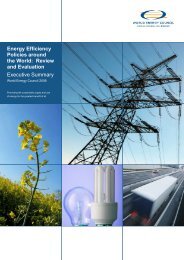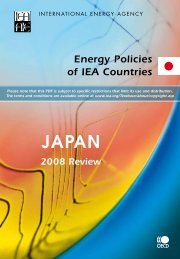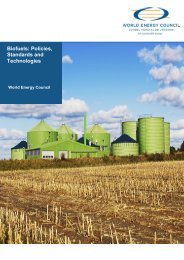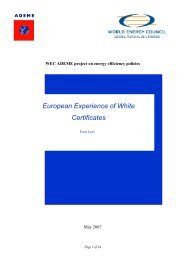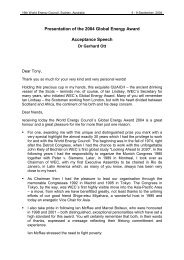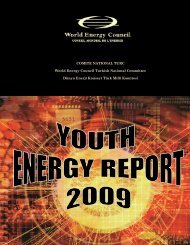Deciding the Future: Energy Policy Scenarios to 2050
Deciding the Future: Energy Policy Scenarios to 2050
Deciding the Future: Energy Policy Scenarios to 2050
Create successful ePaper yourself
Turn your PDF publications into a flip-book with our unique Google optimized e-Paper software.
20<br />
<strong>Deciding</strong> <strong>the</strong> <strong>Future</strong>: <strong>Energy</strong> <strong>Policy</strong> <strong>Scenarios</strong> <strong>to</strong> <strong>2050</strong> World <strong>Energy</strong> Council 2007 The 3 A’s<br />
In North America Acceptability is a large issue, particularly in <strong>the</strong><br />
areas of large future energy developments (unconventional and<br />
enhanced oil development, new nuclear power plants, development of<br />
frontier lands (oil, natural gas, and hydropower). The challenge is <strong>to</strong><br />
implement more effective public information and education<br />
programmes, as well as more effective approval and regula<strong>to</strong>ry<br />
processes <strong>to</strong> ensure reliable and timely improvements in energy<br />
infrastructure.<br />
Environmental questions of a local nature, such<br />
as those related <strong>to</strong> hydroelectric generation or<br />
monocultures as energy sources, are common<br />
in <strong>the</strong> majority of <strong>the</strong> region’s countries.<br />
Questions of a global nature, particularly<br />
emissions from burning fossil fuels, are common<br />
<strong>to</strong> all countries, all of which must introduce<br />
measures <strong>to</strong> reduce such global impacts.<br />
2.2.5. North America<br />
The North America region rates itself as above<br />
<strong>the</strong> middle with regard <strong>to</strong> its current state of<br />
achieving <strong>the</strong> 3 A’s and still has <strong>to</strong> make some<br />
progress. In <strong>the</strong> context of <strong>the</strong> 3 A’s, <strong>the</strong><br />
dominant one for North America is Acceptability.<br />
The challenge for both Availability and<br />
Acceptability is <strong>to</strong> implement more effective<br />
public information and education programmes,<br />
as well as more effective approval and<br />
regula<strong>to</strong>ry processes <strong>to</strong> ensure reliable and<br />
timely improvements in energy infrastructure.<br />
Accessibility<br />
For North America, access <strong>to</strong> abundant energy<br />
resources, combined with its successful<br />
development and utilisation, has contributed <strong>to</strong><br />
its overall economic development and<br />
prosperity. In all three countries (Canada,<br />
Mexico, and <strong>the</strong> United States of America),<br />
extensive energy resources, with appropriate<br />
stewardship and management, will continue <strong>to</strong><br />
contribute <strong>to</strong> economic prosperity of <strong>the</strong> region<br />
for <strong>the</strong> next half-century. This is particularly true<br />
in <strong>the</strong> United States and Canada; in Mexico,<br />
however, <strong>the</strong>re is greater concern. Some 5% of<br />
<strong>the</strong> Mexican population has no access <strong>to</strong><br />
electricity. In addition, in a few isolated<br />
communities in Canada and <strong>the</strong> United States,<br />
access is an issue ei<strong>the</strong>r because of isolation or<br />
because of cost.<br />
Availability<br />
In North America, <strong>the</strong>re are two issues with<br />
respect <strong>to</strong> security of energy supply. The first is<br />
related <strong>to</strong> <strong>the</strong> high degree of dependence on<br />
imported oil from o<strong>the</strong>r regions of <strong>the</strong> world,<br />
which is perceived <strong>to</strong> be unreliable. This is a<br />
problem especially for <strong>the</strong> United States,<br />
because it imports 50% of its oil. The second<br />
issue is <strong>the</strong> combination of reliability and<br />
vulnerability of existing energy systems <strong>to</strong><br />
maintain a reliable supply - because of supply–<br />
demand tightness and vulnerability <strong>to</strong> extreme<br />
climatic (e.g., hurricanes) and terrorist attacks.<br />
Although 95% of <strong>the</strong> Mexican population has<br />
access <strong>to</strong> electricity, this supply is unreliable and<br />
<strong>the</strong> present level of reliability is only on <strong>the</strong> order<br />
of 15% that of <strong>the</strong> rest of North America.<br />
Lastly, <strong>the</strong>re is a related issue in all three North<br />
American countries arising from challenges in<br />
<strong>the</strong> approval of energy plants and infrastructure.<br />
Local opposition, referred <strong>to</strong> as <strong>the</strong> NIMBY (Not<br />
In My Back Yard) phenomenon, is increasing.<br />
Demand has continued <strong>to</strong> grow, while supply<br />
has not kept pace, which results in situations<br />
where <strong>the</strong> supply–demand balance has become<br />
very tight, with consequent increase in<br />
vulnerability <strong>to</strong> supply interruptions. Supply<br />
being curtailed or voltage being reduced (for<br />
electricity systems) is increasingly being<br />
implemented <strong>to</strong> maintain supply. In addition,



